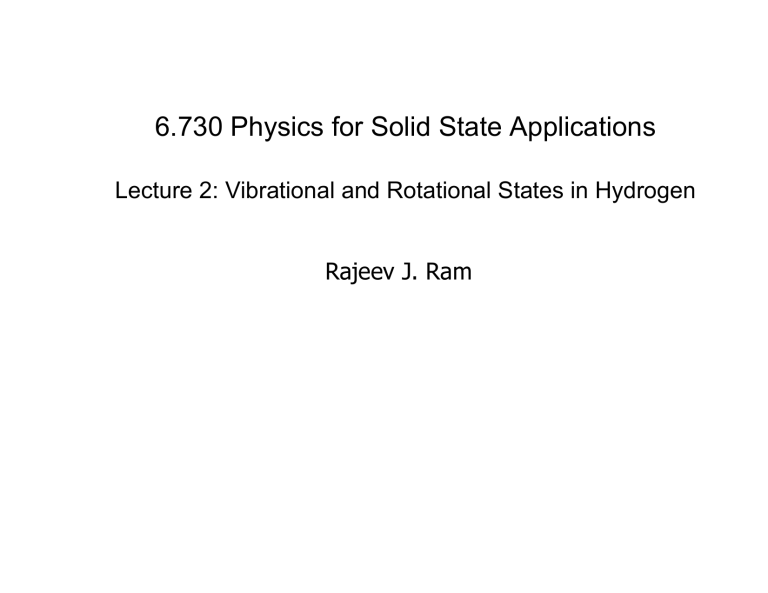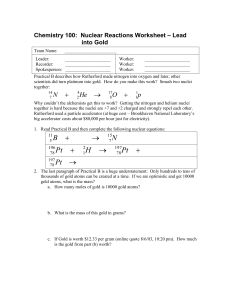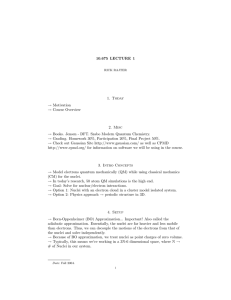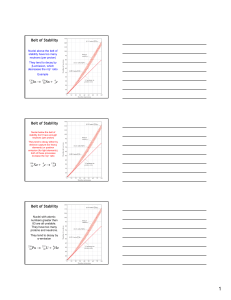6.730 Physics for Solid State Applications Rajeev J. Ram
advertisement

6.730 Physics for Solid State Applications Lecture 2: Vibrational and Rotational States in Hydrogen Rajeev J. Ram Review Lecture 1: H2 , the wavefunction for the entire system of nuclei and electrons me M1 R1 r R2 M2 Approximate Models: Simplifying H2 Born-Oppenheimer Approximation The electrons are much lighter than the nuclei (me/mH≅1/1836), their motion is much faster than the vibrational and rotational motions of the nuclei within the molecule. Î Works since vibrational and rotational energy of molecule is typically much less than the binding energy Linear Combination of Atomic Orbitals (LCAO) Even the electron part of the problem is too hard to solve exactly Born-Oppenheimer Approximation me M1 R1 Electronic Part: Nuclear Part: where E is the energy of the entire molecule r R2 M2 Approximate Electronic Energy (Energy - IH) / IH Nuclear and Electronic Energy Together First Excited State Energy: Antibonding (Energy - IH) / IH First Excited State Energy: LCAO Decrease of electron density Increase of electron density A Closer Look at Nuclear Motion Molecular Vibration and Rotation me M1 R1 r M2 R2 LCAO for electron in Veff Divide and Conquer me M1 R1 r M2 Born-Oppenheimer R2 Center-of-mass and Relative nuclear motion Vibrational and rotational motion LCAO for electron in Veff Center-of-Mass and Relative Nuclear Motion Center-of-mass Note that R is the C-of-M coordinate now Relative Center-of-Mass and Relative Nuclear Motion Total energy is the sum of CM motion and relative: If this is the total energy, where is the electron energy ? Center-of-Mass Nuclear Motion Schrodinger equation for center-of-mass is same as free particle: Eigenstate: Eigenenergy: me me M1 M2 center-of-mass M1 M2 Relative Nuclear Motion Schrodinger equation for relative motion is a central potential problem just like the hydrogen atom: Radial kinetic energy Angular kinetic energy is the angular momentum operator Relative Nuclear Motion Separation of Radial and Angular Components is the spherical Bessel function Vibrational Motion of Nuclei Harmonic Oscillator (Energy - IH) / IH For no rotation, this simplifies to… Vibrational Motion of Nuclei Harmonic Oscillator Approximation: Born-Oppenheimer, parabolic effective potential Vibrational Motion of Nuclei Rigid Rotor Assuming that the vibrational motion produces only small displacements… Divide and Conquer me M1 R1 r M2 R2 Approximations • Born-Oppenheimer • Nuclei inside electron cloud act as if they are embedded in an elastic medium (Veff) Effective potential (Veff) is parabolic Vibrations of simple harmonic oscillator • Rigid rotor Vibrations only displace nuclei slightly from equilibrium bond length Total Energy of the H2 Molecule Binding Vibrational Rotational H2 1.4 eV 0.5 (n + ½) eV 7.5 l (l+1) meV O2 1.0 eV 0.1 (n + ½) eV 30 l (l +1) meV 30 THz 3-30 THz 0.3-3 THz Translational Generalizations from Molecules to Solids • The source of the binding energy is primarily the electrostatic potential between the nuclei and the electrons. The localization energy can also play a role (metal). • Nuclear motions of the ions contribute a very small part to the binding energy. • Sharing electrons between nuclei lowers the energy of the solid. • The potential between the nuclei is of the same form as the molecule. • Exicted states exists. Assumptions for Electronic States • One electron energy levels • No spin or exchange energies • LCAO a good approximation • Ignore motion of the nuclei to first order




